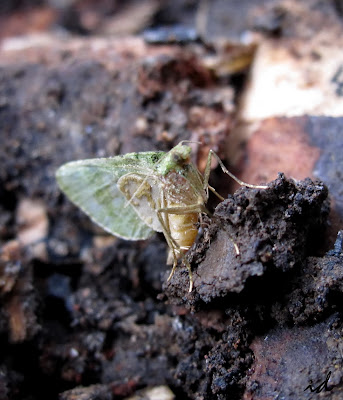Coin Spider from Manglayang Mt.
Coin Spider from Manglayang Mt.
| Kingdom: | Animalia |
| Phylum: | Arthropoda |
| Class: | Arachnida |
| Order: | Araneae |
| Suborder: | Araneomorphae |
| Family: | Nephilidae |
| Genus: | Herennia |
| Species: | H. etruscilla |
Herennia Etruscilla aka. coin spider is an endemic to java, and I get lucky to met this one. I get the exact id from karl from whatsthatbug.com, here is what karl say about the identification:
Hi Daniel and Mohamad:This beautiful spider is a Golden Orb Weaver in the family Nephilidae (formerly grouped under the Araneidae and Tetragnathidae). The genus is Herennia, and it has an Australasian distribution (India to the Solomon Islands). This is a very small genus with only 11 known species, usually referred to as Coin Spiders, most of which have been described only within the last decade. The island of Java apparently has two species; H. multipuncta is widespread throughout South and Southeast Asia and H. etruscilla is endemic to Java. There are several online images of H. multipuncta and they don’t match the one in this post. The definitive paper on the genus is “A Revision of Herennia (Araneae: Nephilidae: Nephilinae), the Australasian ‘coin spiders’ “ by Kuntner (2005), in which both the detailed descriptions and photos of H. etruscilla provide a very good match to Mohamad’s spider. The unique webs are referred to as ladder webs and if you are interested in learning more you can check out another paper by Kuntner et al. (2009) [see: 9fcfd50cb81b07c8ae]. These spiders also exhibit some interesting sexual behavior. They demonstrate extreme sexual dimorphism, not unusual among spiders, but once engaged in copulation the males stay put, acting as a genital plug that prevents other males from fertilizing the female. In addition to Coin Spiders, common names also include Ornamental Step Ladder Spiders and Ornamental Tree Trunk Spiders. Thanks Mohamad, for a very interesting submission. Regards. Karlp.s. Daniel, my computer seems to have difficulty with hyperlinks to pdf files. Let me know if the links to the Kuntner papers don’t work and I can send you the full addresses. Karl
The magnificent thing... it is true from what karl say about the "ladder web", it is just like a ladder on a pine tree from bottom to top. I don't know why the spider built these kind of webs but simply majestic!.
Here's some photo of those beautiful creatures.
 |
| H. etruscilla at night |
 |
| H. etruscilla at daylight |



























































0 comments:
Post a Comment